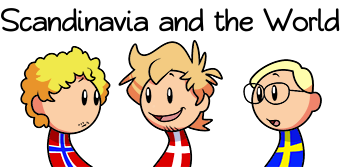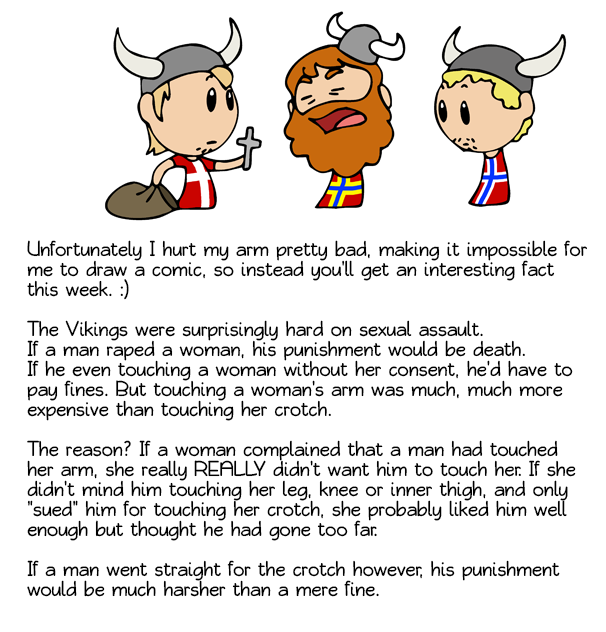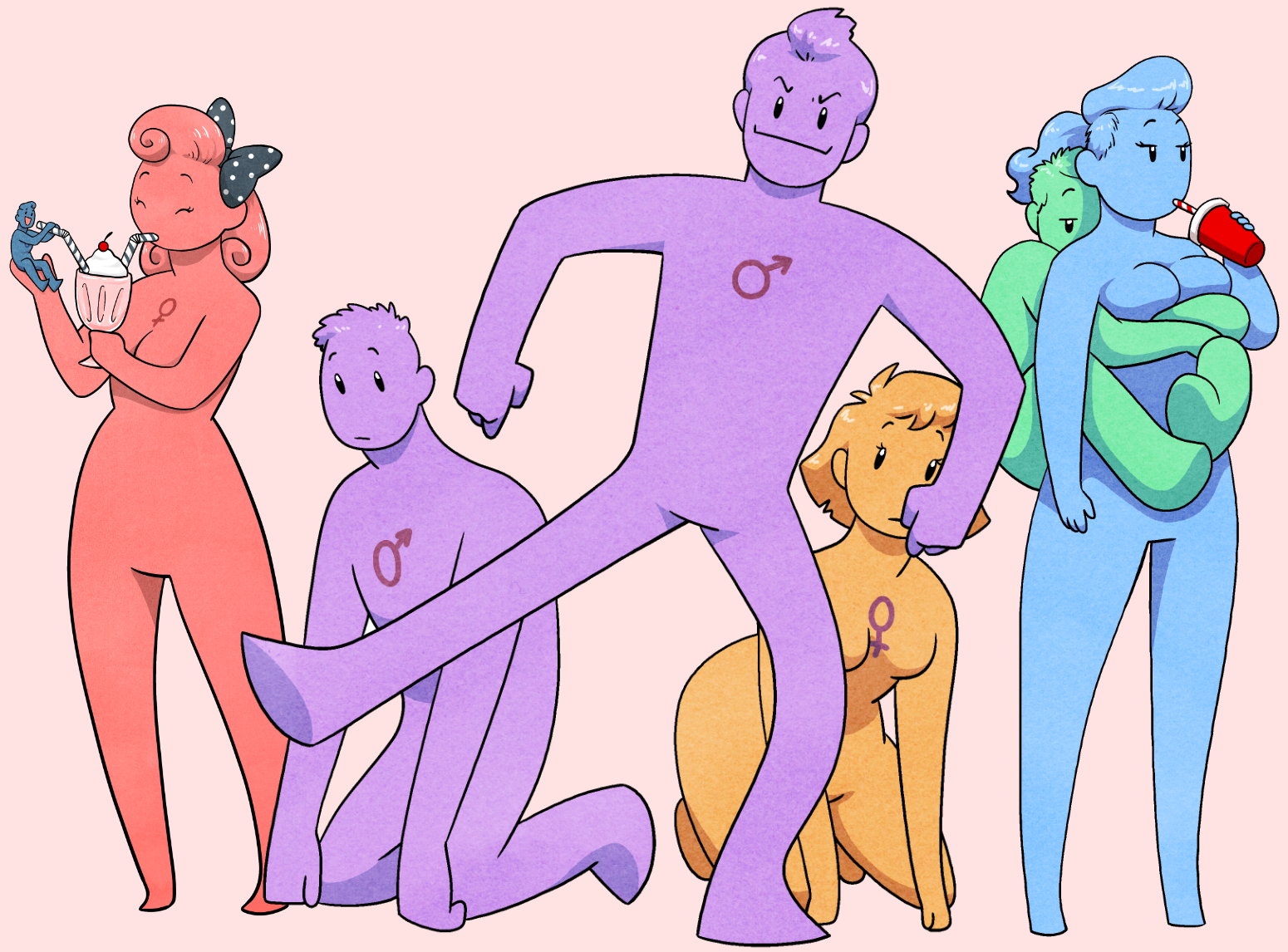10 years ago #9434585
10
0
Sometimes I wonder where Humon gets her sources from. The Vikings didn't write down the laws until the introduction to Christianity and all the stories we know about the Viking society was primarily written down by outsiders, found in archaeological excavation or the Sagas which was written down hundreds of years after the introduction to Christianity. I guess this must be the Viking kingdoms in England or something, as I've never heard of such laws existing in Scandinavia. I do know that Olaf Haraldsson II of Norway did introduce something called the Christian Right, no Americans it's not some Republican right-wing movement, it was a series of laws which said a lot of different things and one thing they did was make punishment of rape and female kidnappings harsher.
In any case, what Humon tells might be true for all I know, just like the part about Vikings being particular concerned about their appearance, but just like that comic she doesn't tell how we know this. There are no records that the Vikings were particular brutal in cases of rape from either Christian or pagan sources. That's not to say they didn't rape, only that this was not something the Vikings were known for. Since women did enjoy more rights in Norse society than in the European society this does fit with women being having a high view on. But I'm also always careful when I read or hear patronising things about the Vikings as many people are biased and want to use the past to make a modern point. I see this all the time, whether it's about women's rights, democracy, abortion, gay rights, religious tolerance and etc. In any case, the patronising of the Vikings must also be understood as a counter reaction to the very negative view people in scholarship and many laypeople have had in the past.
In any case, what Humon tells might be true for all I know, just like the part about Vikings being particular concerned about their appearance, but just like that comic she doesn't tell how we know this. There are no records that the Vikings were particular brutal in cases of rape from either Christian or pagan sources. That's not to say they didn't rape, only that this was not something the Vikings were known for. Since women did enjoy more rights in Norse society than in the European society this does fit with women being having a high view on. But I'm also always careful when I read or hear patronising things about the Vikings as many people are biased and want to use the past to make a modern point. I see this all the time, whether it's about women's rights, democracy, abortion, gay rights, religious tolerance and etc. In any case, the patronising of the Vikings must also be understood as a counter reaction to the very negative view people in scholarship and many laypeople have had in the past.
10 years ago #9434448
8
11
I honestly don't find it surprising. the vikings were huge on gender equality.
1. Research has found that in invading vikings, there was literally a 50% chance that the invader was female.
2. The mere concept of Valkyries nuke a lot of "traditional gender role" ideas from orbit.
3. Although the words "man" and "woman" originate with the norse/germanic, they actually didn't originally mean male and female. You actually had to go out of your way to specificy gender (a person could be a male man or a female man.) Man literally meant what we mean by human now. (And human meant a man who acts like a man... aka, humanely.) Women didn't mean female, it meant a man who wasn't head of household (which could be male or female. In fact, all boys and girls were all considered women). Further, a term that is now gone, is Werman, which meant head of household. Both a male or a female could be a Werman. It was completely fine to have a female Werman and a male woman. (Or a male and male werman and woman even).
The whole "man is male" and "woman is female" didn't come about until the Christian religions invaded the north and forced their religion and their gender roles onto the Norse social roles.
Reading between the lines, it seems it's possible that's where the term "Were-" as in werewolf got it's name... Wermen were used to being in charge of their area and taking care of those under them, and the church saw that as how the *church* should be seen, and told the wermen that they weren't wermen, just men. Then stories turning wermen into beasts... werewolves... cicrulated. Basically social engineering to dominate and destroy the culture and instil the catholic church as dominant.
1. Research has found that in invading vikings, there was literally a 50% chance that the invader was female.
2. The mere concept of Valkyries nuke a lot of "traditional gender role" ideas from orbit.
3. Although the words "man" and "woman" originate with the norse/germanic, they actually didn't originally mean male and female. You actually had to go out of your way to specificy gender (a person could be a male man or a female man.) Man literally meant what we mean by human now. (And human meant a man who acts like a man... aka, humanely.) Women didn't mean female, it meant a man who wasn't head of household (which could be male or female. In fact, all boys and girls were all considered women). Further, a term that is now gone, is Werman, which meant head of household. Both a male or a female could be a Werman. It was completely fine to have a female Werman and a male woman. (Or a male and male werman and woman even).
The whole "man is male" and "woman is female" didn't come about until the Christian religions invaded the north and forced their religion and their gender roles onto the Norse social roles.
Reading between the lines, it seems it's possible that's where the term "Were-" as in werewolf got it's name... Wermen were used to being in charge of their area and taking care of those under them, and the church saw that as how the *church* should be seen, and told the wermen that they weren't wermen, just men. Then stories turning wermen into beasts... werewolves... cicrulated. Basically social engineering to dominate and destroy the culture and instil the catholic church as dominant.
10 years ago #9434493
7
1
Fines for merely touching arm? So Sweden was the feminist stronghold even in the viking era.
7 years ago #9797741
4
0
Sort of yes...sort of no. This would only be true of a woman who had such protection. Most women didn't. Most were low-caste thralls. Also, all this went out the window during raids, in which case women were frequently kidnapped to be sex-slave-wives--obviously without consent. As a sex-slave-wife, you got what protections your high class owner-husband decided to give you and no more.
8 years ago #9711523
4
0
Everyone says that Vikings were ruthless, savage barbarians, and then I learn that they didn't allow sexual assault in their ancient communities. That's a ice thing to know.
10 years ago #9441186
4
0
Just signed up to add a comment on this. While I'm not really sure about the contents of early medieval Scandinavian law, I'll echo the comments that most are post-Viking age (isn't there a law manuscript in the form of an inscribed metal ring in Sweden, dating to the ?ninth century though? does that have anything about touching women?).
An interesting parallel though is found in the laws of the Salian Franks, clause 20 of the Merovignian 'Pactis Legis Salicae' and emedned to clause 22 in the Carolingian update the Lex Salica Karolina both adress the touching of women 's hands. Using Kaththerine Fischer-Drews English translation (which, I accept has many problems, yes), outlines fines of:
* six-hundrd denarii for if a freeman touches the 'hand, arm or finger' of a free woman,
* twelve-hundred denarii for touching her 'below the elbow',
* fourteen-hundred for touching above the elbow.
* eighteen-hundred denarii for touching 'a woman's breast or cutting it so that the blood flows'
Clearly this isn't a perfect parallel to the content of the Viking laws mentioned above, but considering that the nationalism of the nineteenth and early twentieth centuries considered these laws as variant manifestations of an underlying, widespread 'Germanic' culture it's possible that it was read across and into the pre/protoliterate Scandinavian legal context.
On the one hand, as the final part of clause 20 of the Pactis makes no distinction between 'touching' and a cut that bleeds, 'touching' may not be the best translation (i've not yet checked the Latin in critical editions or in the manuscripts) and grabbing or grappling may be intended. On the other hand, it's been argued across the 'barbarian laws' (e.g. by Lise Oliver in general and by Alice Rio for the Franks in particular) that the values given most probably represent *maximum* fines that could be awarded, and that judges might reduce the actual amount according to the broader circumstances.
...and I really need to find the time to go and read up more on this
An interesting parallel though is found in the laws of the Salian Franks, clause 20 of the Merovignian 'Pactis Legis Salicae' and emedned to clause 22 in the Carolingian update the Lex Salica Karolina both adress the touching of women 's hands. Using Kaththerine Fischer-Drews English translation (which, I accept has many problems, yes), outlines fines of:
* six-hundrd denarii for if a freeman touches the 'hand, arm or finger' of a free woman,
* twelve-hundred denarii for touching her 'below the elbow',
* fourteen-hundred for touching above the elbow.
* eighteen-hundred denarii for touching 'a woman's breast or cutting it so that the blood flows'
Clearly this isn't a perfect parallel to the content of the Viking laws mentioned above, but considering that the nationalism of the nineteenth and early twentieth centuries considered these laws as variant manifestations of an underlying, widespread 'Germanic' culture it's possible that it was read across and into the pre/protoliterate Scandinavian legal context.
On the one hand, as the final part of clause 20 of the Pactis makes no distinction between 'touching' and a cut that bleeds, 'touching' may not be the best translation (i've not yet checked the Latin in critical editions or in the manuscripts) and grabbing or grappling may be intended. On the other hand, it's been argued across the 'barbarian laws' (e.g. by Lise Oliver in general and by Alice Rio for the Franks in particular) that the values given most probably represent *maximum* fines that could be awarded, and that judges might reduce the actual amount according to the broader circumstances.
...and I really need to find the time to go and read up more on this
10 years ago #9434750
3
0
I like that the punishment would fall on the man and not the woman. I mean, in some cultures it is the woman who will be punished for being raped or assaulted <.<''
Add comment: Please Sign in or create an accout to comment.




 Support the comic on
Support the comic on 





































52